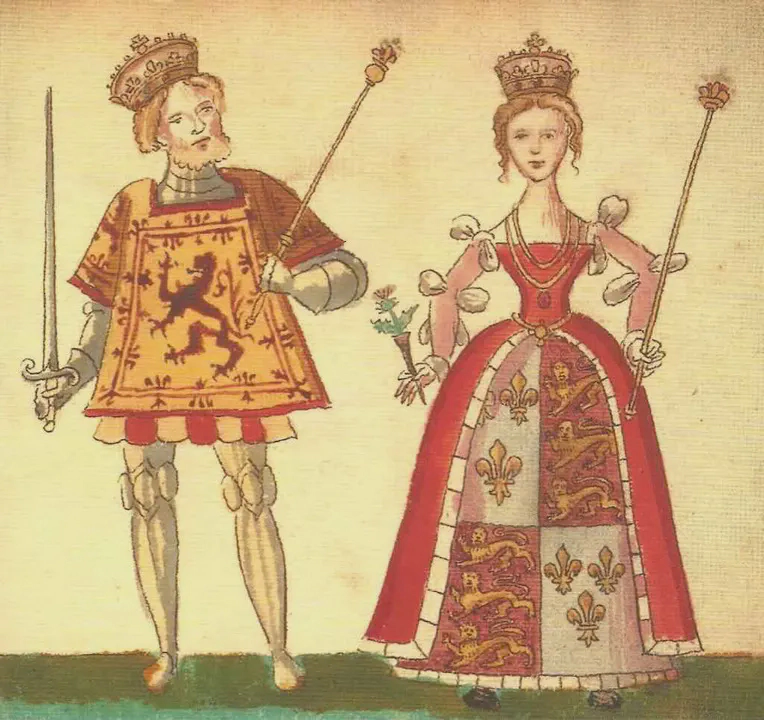On December 04, 1423 in Celtic History
James i, is released from 18 years captivity in england

James I (late July 1394 – 21 February 1437) was King of Scots from 1406 until his assassination in 1437.
Joan Beaufort (c. 1404 – 15 July 1445) was Queen of Scotland from 1424 to 1437 as the spouse of King James I of Scotland.
Joan’s family began to see political advantage in a marriage with the King of Scots and began working on getting James released from prison. Negotiations were started in August of 1423 and a treaty was finalized on December 04, including a marriage between James and Joan on 12 February 1424.
Joan Beaufort and King James were wed at St Mary Overie Church in Southwark.[

James Early Days
James was the youngest of three sons, he was born in Dunfermline Abbey to King Robert III and Annabella Drummond.
His older brother David, Duke of Rothesay, died under suspicious circumstances during detention by their uncle, Robert, Duke of Albany.
James’ other brother, Robert, died young.
Moved to France for Safety
Fears surrounding James’s safety grew through the winter of 1405/06 and plans were made to send him to France
1406
In February 1406, James was forced to take refuge in the castle of the Bass Rock in the Firth of Forth after his escort was attacked by supporters of Archibald, 4th Earl of Douglas. He remained at the castle until mid-March, when he boarded a vessel bound for France.
Captured by English Pirates
On 22 March, English pirates captured the ship and delivered the prince to Henry IV of England.
11 Year Old James Hostage for 18 Years
The ailing Robert III died on 4 April and the 11-year-old James, now the uncrowned King of Scots, would not regain his freedom for another eighteen years.
James was educated well during his English imprisonment, sometimes in the Tower of London, Windsor Castle, and other English castles. He seems to have been generally well-treated, and he developed a respect for English methods of governance.
His uncle, Robert, Duke of Albany. transitioned from his position of lieutenant to that of governor. Albany took James’s lands under his own control, depriving the king of income and any of the regalia of his position, and was referred to in records as ’the son of the late king'.
From Hostage to House Guest
By 1420, James’s standing at Henry V’s court improved greatly; he ceased to be regarded as a hostage and more of a guest. James’s value to Henry became apparent in 1420 when he accompanied the English king to France where his presence was used against the Scots fighting on the Dauphinist side. Following the English success at the siege of Melun, a town southeast of Paris, the contingent of Scots were hanged for treason against their king.
Henry appointed the Duke of Bedford and James as the joint commanders of the siege of Dreux on 18 July 1421 and, on 20 August, they received the surrender of the garrison. Henry died of dysentery on 31 August 1422 and, in September, James was part of the escort taking the English king’s body back to London.
The regency council of the infant King Henry VI was inclined to have James released as soon as possible. In the early months of 1423, their attempts to resolve the issue met with little response from the Scots, clearly influenced by the Albany Stewarts and adherents.
Release and Reign
Meantime, Albany and the Scottish nobility came to an agreement with the English regency council for the release of James. It was all about money – England needed funds and the Scots argued for a staggered payment.
For the sum of 60,000 marks, less 10,000 for Joan’s dowry, the Treaty of London saw James freed in April 1424.
He then began his formal reign as King of Scots. His reign was marked by efforts to strengthen royal authority and centralize power.
Policies and Governance
James I implemented various reforms to consolidate his power, including efforts to curb the influence of the nobility. He also sought to improve governance and the administration of justice.
Literary and Cultural Contributions
James I was a patron of literature and the arts. He wrote poetry in both Scots and English and is known for “The Kingis Quair” (“The King’s Book”), a romantic poem written during his captivity.
Assassination
James I faced opposition from some nobles who resented his attempts to limit their power. He was assassinated on February 21, 1437, in Perth, marking a tumultuous end to his reign.
Related Content

Shane Patrick Lysaght MacGowan, lead singer of the Pogues, died

St Machar Day, patron saint of Aberdeen

Oíche Shamhna - Cetlic New Year Eve (Halloween)

ALBAN ELFED (Welsh Bardic name for autumn equinox)

Feast day of St. James

John Davie Burgess, King of the Highland Pipers, died at age 71.